Cohen I.M., Kundu P.K. Fluid Mechanics
Подождите немного. Документ загружается.

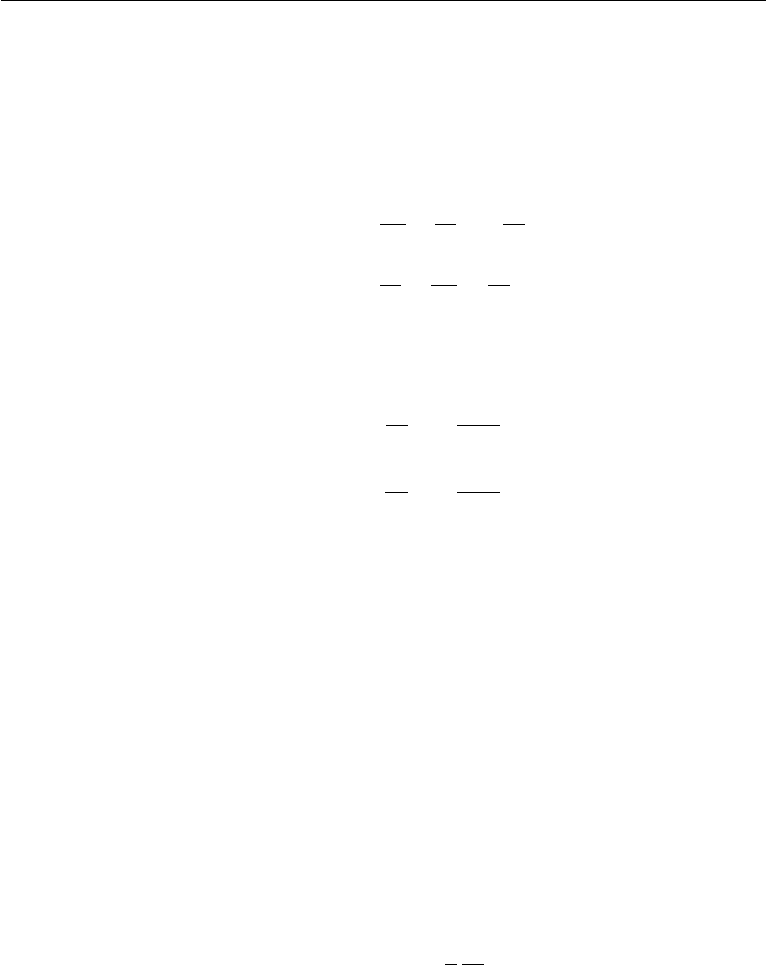
622 Geophysical Fluid Dynamics
Explanation in Terms of Vortex Tilting
We have seen in previous chapters that the thickness of a viscous layer usually grows
in a nonrotating flow, either in time or in the direction of flow. The Ekman solution,
in contrast, results in a viscous layer that does not grow either in time or space. This
can be explained by examining the vorticity equation (Pedlosky, 1987). The vorticity
components in the x- and y-directions are
ω
x
=
∂w
∂y
−
∂v
∂z
=−
dv
dz
,
ω
y
=
∂u
∂z
−
∂w
∂x
=
du
dz
,
where we have used w = 0. Using these, the z-derivative of the equations of motion
(14.22) and (14.23) gives
−f
dv
dz
= ν
v
d
2
ω
y
dz
2
,
−f
du
dz
= ν
v
d
2
ω
x
dz
2
.
(14.31)
The right-hand side of these equations represent diffusion of vorticity. Without
Coriolis forces this diffusion would cause a thickening of the viscous layer. The
presence of planetary rotation, however, means that vertical fluid lines coincide with
the planetary vortex lines. The tilting of vertical fluid lines, represented by terms on
the left-hand sides of equations (14.31), then causes a rate of change of horizontal
component of vorticity that just cancels the diffusion term.
7. Ekman Layer on a Rigid Surface
Consider now a horizontally independent and steady viscous layer on a solid surface
in a rotating flow. This can be the atmospheric boundary layer over the solid earth or
the boundary layer over the ocean bottom. We assume that at large distances from the
surface the velocity is toward the x-direction and has a magnitude U. Viscous forces
are negligible far from the wall, so that the Coriolis force can be balanced only by a
pressure gradient:
fU =−
1
ρ
dp
dy
. (14.32)
This simply states that the flow outside the viscous layer is in geostrophic balance,
U being the geostrophic velocity. For our assumed case of positive U and f ,we
must have dp/dy < 0, so that the pressure falls with y—that is, the pressure force is
directed along the positive y direction, resulting in a geostrophic flow U to the right

7. Ekman Layer on a Rigid Surface 623
of the pressure force in the northern hemisphere. The horizontal pressure gradient
remains constant within the thin boundary layer.
Near the solid surface the viscous forces are important, so that the balance within
the boundary layer is
−fv = ν
v
d
2
u
dz
2
, (14.33)
fu= ν
v
d
2
v
dz
2
+ fU, (14.34)
where we have replaced −ρ
−1
(dp/dy) by fU in accordance with equation (14.32).
The boundary conditions are
u = U, v = 0asz →∞, (14.35)
u = 0 ,v= 0atz = 0, (14.36)
where z is taken vertically upward from the solid surface. Multiplying equation (14.34)
by i and adding equation (14.33), the equations of motion become
d
2
V
dz
2
=
if
ν
v
(V − U), (14.37)
where we have defined the complex velocity V ≡ u + iv. The boundary
conditions (14.35) and (14.36) in terms of the complex velocity are
V = U as z →∞, (14.38)
V = 0atz = 0. (14.39)
The particular solution of equation (14.37) is V = U . The total solution is, therefore,
V = Ae
−(1+i)z/δ
+ Be
(1+i)z/δ
+ U, (14.40)
where δ ≡
√
2ν
v
/f . To satisfy equation (14.38), we must have B = 0. Condition
(14.39) gives A =−U . The velocity components then become
u = U [1 − e
−z/δ
cos (z/δ)],
v = Ue
−z/δ
sin (z/δ).
(14.41)
According to equation (14.41), the tip of the velocity vector describes a spiral for
various values of z (Figure 14.9a). As with the Ekman layer at a free surface, the
frictional effects are confined within a layer of thickness δ =
√
2ν
v
/f , which increases
with ν
v
and decreases with the rotation rate f . Interestingly, the layer thickness is
independent of the magnitude of the free-stream velocity U ; this behavior is quite
different from that of a steady nonrotating boundary layer on a semi-infinite plate (the
Blasius solution of Section 10.5) in which the thickness is proportional to 1/
√
U.
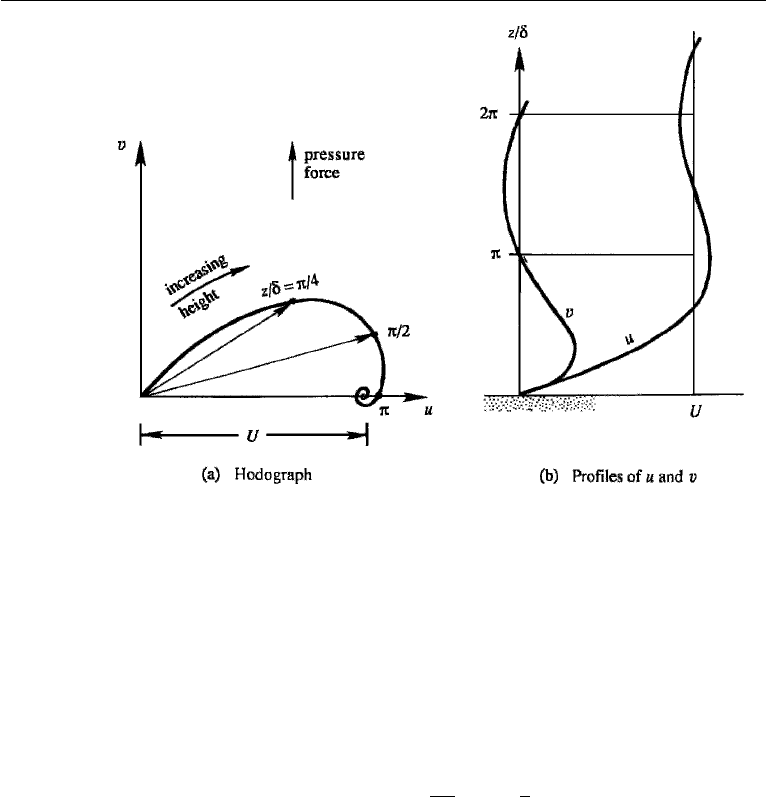
624 Geophysical Fluid Dynamics
Figure 14.9 Ekman layer at a rigid surface. The left panel shows velocity vectors at various heights;
values of z/δ are indicated along the curve traced out by the tip of the velocity vectors. The right panel
shows vertical distributions of u and v.
Figure 14.9b shows the vertical distribution of the velocity components. Far from
the wall the velocity is entirely in the x-direction, and the Coriolis force balances the
pressure gradient. As the wall is approached, retarding effects decrease u and the
associated Coriolis force, so that the pressure gradient (which is independent of z)
forces a component v in the direction of the pressure force. Using equation (14.41),
the net transport in the Ekman layer normal to the uniform stream outside the layer is
∞
0
vdz= U
ν
v
2f
1/2
=
1
2
Uδ,
which is directed to the left of the free-stream velocity, in the direction of the pressure
force.
If the atmosphere were in laminar motion, ν
v
would be equal to its molecular
value for air, and the Ekman layer thickness at a latitude of 45
◦
(where f 10
−4
s
−1
)
would be ≈δ ∼ 0.4 m. The observed thickness of the atmospheric boundary layer
is of order 1 km, which implies an eddy viscosity of order ν
v
∼ 50 m
2
/s. In fact,
Taylor (1915) tried to estimate the eddy viscosity by matching the predicted velocity
distributions (14.41) with the observed wind at various heights.
The Ekman layer solution on a solid surface demonstrates that the three-way
balance among the Coriolis force, the pressure force, and the frictional force within
the boundary layer results in a component of flow directed toward the lower pressure.
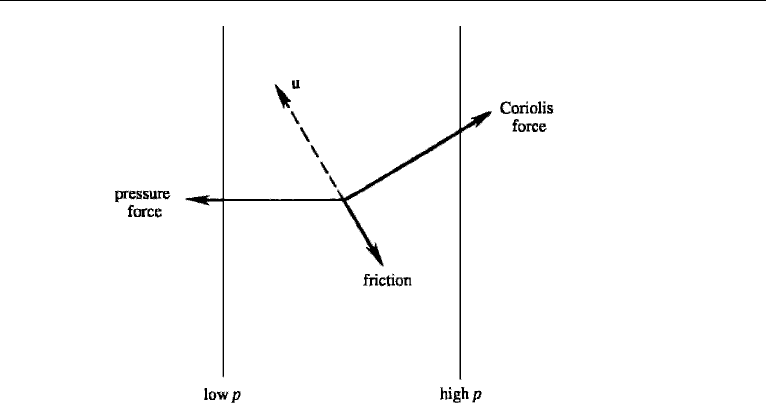
8. Shallow-Water Equations 625
Figure 14.10 Balance of forces within an Ekman layer, showing that velocity u has a component toward
low pressure.
The balance of forces within the boundary layer is illustrated in Figure 14.10. The
net frictional force on an element is oriented approximately opposite to the velocity
vector u. It is clear that a balance of forces is possible only if the velocity vector has a
component from high to low pressure, as shown. Frictional forces therefore cause the
flow around a low-pressure center to spiral inward. Mass conservation requires that
the inward converging flow should rise over a low-pressure system, resulting in cloud
formation and rainfall. This is what happens in a cyclone, which is a low-pressure
system. In contrast, over a high-pressure system the air sinks as it spirals outward
due to frictional effects. The arrival of high-pressure systems therefore brings in clear
skies and fair weather, because the sinking air does not result in cloud formation.
Frictional effects, in particular the Ekman transport by surface winds, play a
fundamental role in the theory of wind-driven ocean circulation. Possibly the most
important result of such theories was given by Henry Stommel in 1948. He showed
that the northward increase of the Coriolis parameter f is responsible for making the
currents along the western boundary of the ocean (e.g., the Gulf Stream in theAtlantic
and the Kuroshio in the Pacific) much stronger than the currents on the eastern side.
These are discussed in books on physical oceanography and will not be presented
here. Instead, we shall now turn our attention to the influence of Coriolis forces on
inviscid wave motions.
8. Shallow-Water Equations
Both surface and internal gravity waves were discussed in Chapter 7. The effect
of planetary rotation was assumed to be small, which is valid if the frequency ω
of the wave is much larger than the Coriolis parameter f . In this chapter we are
considering phenomena slow enough for ω to be comparable to f . Consider surface
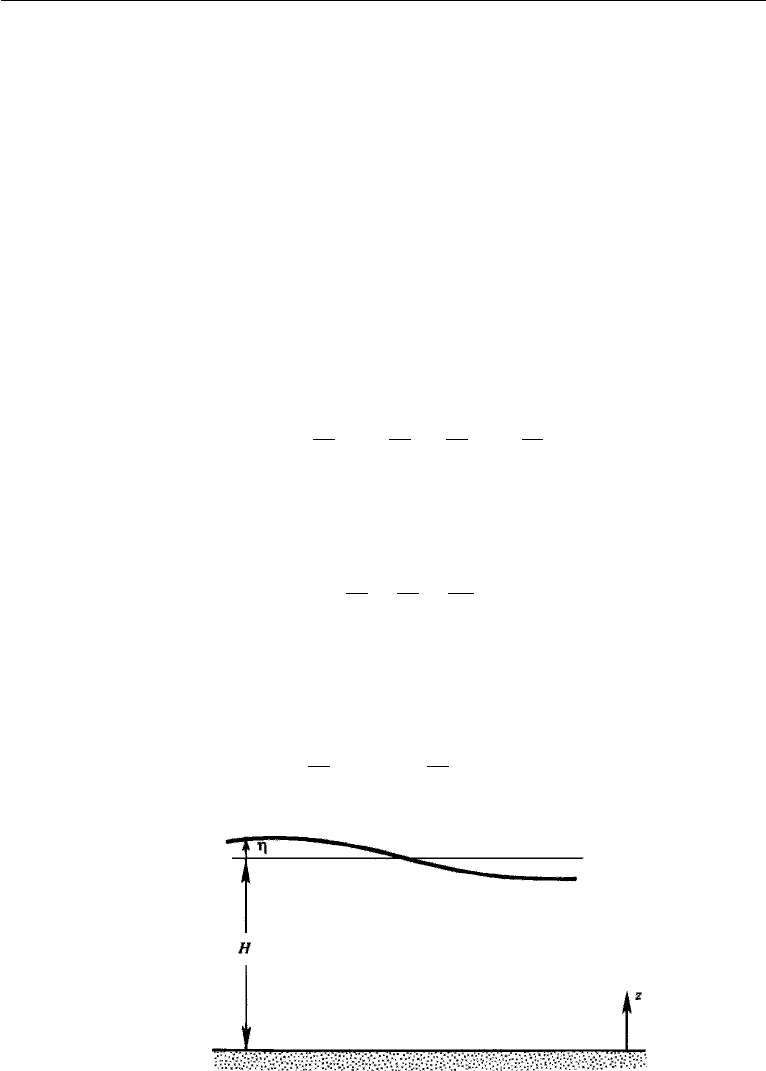
626 Geophysical Fluid Dynamics
gravity waves on a shallow layer of homogeneous fluid whose mean depth is H .Ifwe
restrict ourselves to wavelengths λ much larger than H , then the vertical velocities
are much smaller than the horizontal velocities. In Chapter 7, Section 6 we saw that
the acceleration ∂w/∂t is then negligible in the vertical momentum equation, so that
the pressure distribution is hydrostatic. We also demonstrated that the fluid particles
execute a horizontal rectilinear motion that is independent of z. When the effects
of planetary rotation are included, the horizontal velocity is still depth-independent,
although the particle orbits are no longer rectilinear but elliptic on a horizontal plane,
as we shall see in the following section.
Consider a layer of fluid over a flat horizontal bottom (Figure 14.11). Let z be
measured upward from the bottom surface, and η be the displacement of the free
surface. The pressure at height z from the bottom, which is hydrostatic, is given by
p = ρg(H +η − z).
The horizontal pressure gradients are therefore
∂p
∂x
= ρg
∂η
∂x
,
∂p
∂y
= ρg
∂η
∂y
. (14.42)
As these are independent of z, the resulting horizontal motion is also depth
independent.
Now consider the continuity equation
∂u
∂x
+
∂v
∂y
+
∂w
∂z
= 0.
As ∂u/∂x and ∂v/∂y are independent of z, the continuity equation requires that w
vary linearly with z, from zero at the bottom to the maximum value at the free surface.
Integrating vertically across the water column from z = 0toz = H + η, and noting
that u and v are depth independent, we obtain
(H + η)
∂u
∂x
+ (H + η)
∂v
∂y
+ w(η) − w(0) = 0, (14.43)
Figure 14.11 Layer of fluid on a flat bottom.
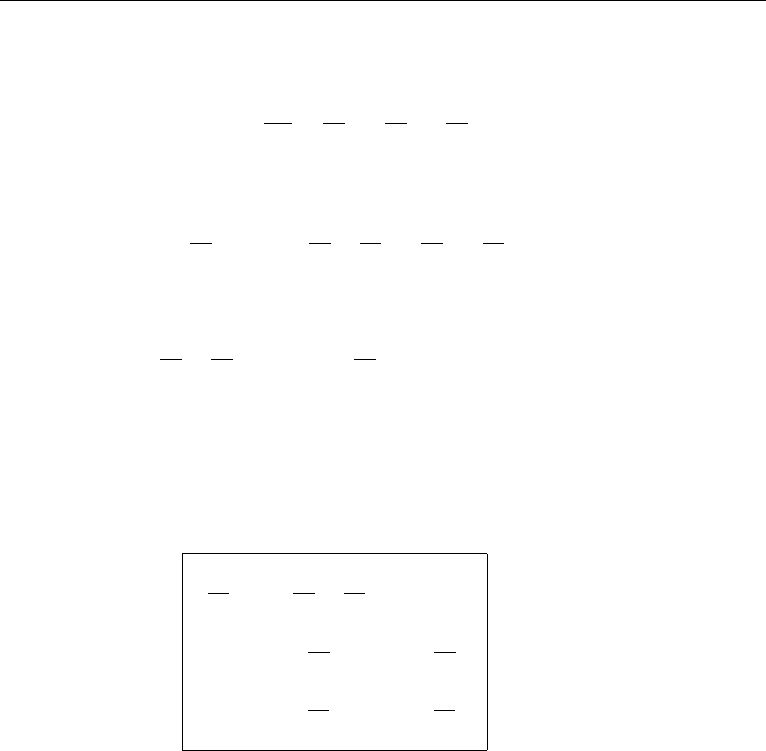
8. Shallow-Water Equations 627
where w(η) is the vertical velocity at the surface and w(0) = 0 is the vertical velocity
at the bottom. The surface velocity is given by
w(η) =
Dη
Dt
=
∂η
∂t
+ u
∂η
∂x
+ v
∂η
∂y
.
The continuity equation (14.43) then becomes
(H + η)
∂u
∂x
+ (H + η)
∂v
∂y
+
∂η
∂t
+ u
∂η
∂x
+ v
∂η
∂y
= 0,
which can be written as
∂η
∂t
+
∂
∂x
[u(H + η)]+
∂
∂y
[v(H + η)]=0. (14.44)
This says simply that the divergence of the horizontal transport depresses the free
surface. For small amplitude waves, the quadratic nonlinear terms can be neglected
in comparison to the linear terms, so that the divergence term in equation (14.44)
simplifies to H ∇
•
u.
The linearized continuity and momentum equations are then
∂η
∂t
+ H
∂u
∂x
+
∂v
∂y
=0,
∂u
∂t
− fv=−g
∂η
∂x
,
∂v
∂t
+ fu=−g
∂η
∂y
.
(14.45)
In the momentum equations of (14.45), the pressure gradient terms are written in the
form (14.42) and the nonlinear advective terms have been neglected under the small
amplitude assumption. Equations (14.45), called the shallow water equations, govern
the motion of a layer of fluid in which the horizontal scale is much larger than the
depth of the layer. These equations will be used in the following sections for studying
various types of gravity waves.
Although the preceding analysis has been formulated for a layer of homogeneous
fluid, equations (14.45) are applicable to internal waves in a stratified medium, if we
replaced H by the equivalent depth H
e
, defined by
c
2
= gH
e
, (14.46)
where c is the speed of long nonrotating internal gravity waves. This will be demon-
strated in the following section.

628 Geophysical Fluid Dynamics
9. Normal Modes in a Continuously Stratified Layer
In the preceding section we considered a homogeneous medium and derived the
governing equations for waves of wavelength larger than the depth of the fluid layer.
Now consider a continuously stratified medium and assume that the horizontal scale
of motion is much larger than the vertical scale. The pressure distribution is therefore
hydrostatic, and the equations of motion are
∂u
∂x
+
∂v
∂y
+
∂w
∂z
= 0, (14.47)
∂u
∂t
− fv =−
1
ρ
0
∂p
∂x
, (14.48)
∂v
∂t
+ fu =−
1
ρ
0
∂p
∂y
, (14.49)
0 =−
∂p
∂z
− gρ , (14.50)
∂ρ
∂t
−
ρ
0
N
2
g
w = 0, (14.51)
where p and ρ represent perturbations of pressure and density from the state of
rest. The advective term in the density equation is written in the linearized form
w(d ¯ρ/dz) =−ρ
0
N
2
w/g, where N(z) is the buoyancy frequency. In this form the
rate of change of density at a point is assumed to be due only to the vertical advection
of the background density distribution ¯ρ(z), as discussed in Chapter 7, Section 18.
In a continuously stratified medium, it is convenient to use the method of separa-
tion of variables and write q =
q
n
(x,y,t)ψ
n
(z) for some variable q. The solution
is thus written as the sum of various vertical “modes,” which are called normal modes
because they turn out to be orthogonal to each other. The vertical structure of a mode is
described by ψ
n
and q
n
describes the horizontal propagation of the mode. Although
each mode propagates only horizontally, the sum of a number of modes can also
propagate vertically if the various q
n
are out of phase.
We assume separable solutions of the form
[u, v, p/ρ
0
]=
∞
n=0
[u
n
,v
n
,p
n
]ψ
n
(z), (14.52)
w =
∞
n=0
w
n
z
−H
ψ
n
(z) dz, (14.53)
ρ =
∞
n=0
ρ
n
dψ
n
dz
, (14.54)
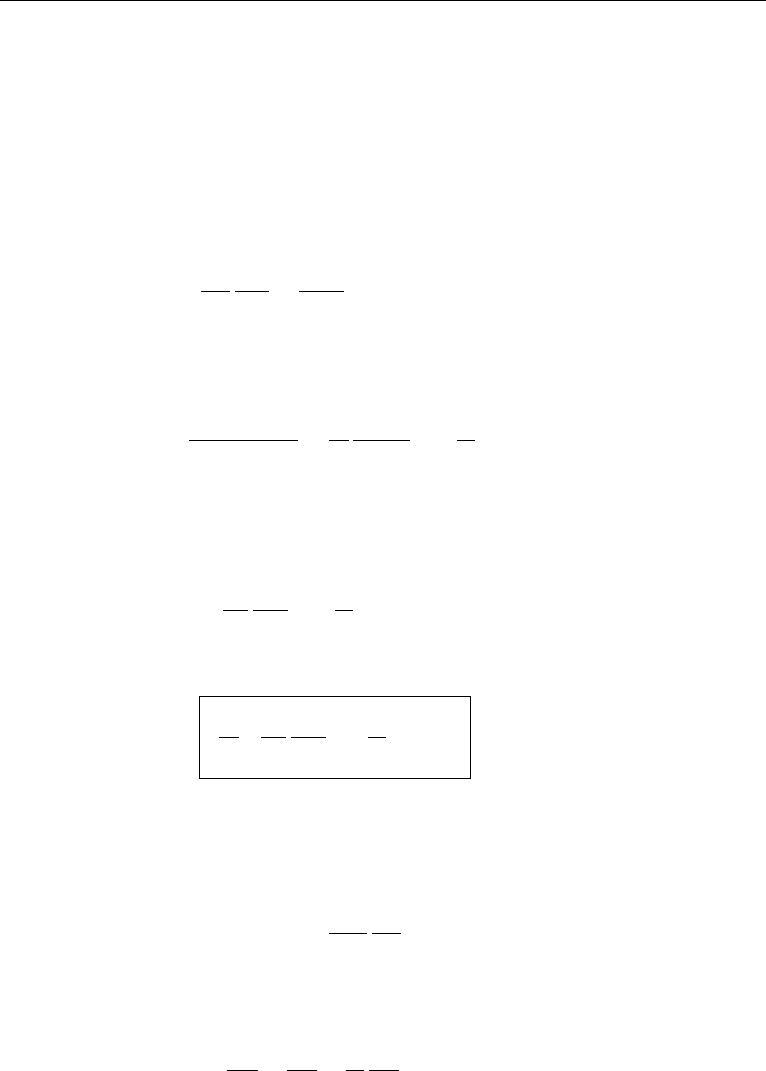
9. Normal Modes in a Continuously Stratified Layer 629
where the amplitudes u
n
, v
n
, p
n
, w
n
, and ρ
n
are functions of (x,y,t). The z-axis
is measured from the upper free surface of the fluid layer, and z =−H represents
the bottom wall. The reasons for assuming the various forms of z-dependence in
equations (14.52)–(14.54) are the following: Variables u, v, and p have the same
vertical structure in order to be consistent with equations (14.48) and (14.49). Con-
tinuity equation (14.47) requires that the vertical structure of w should be the inte-
gral of ψ
n
(z). Equation (14.50) requires that the vertical structure of ρ must be the
z-derivative of the vertical structure of p.
Subsititution of equations (14.53) and (14.54) into equation (14.51) gives
∞
n=0
∂ρ
n
∂t
dψ
n
dz
−
ρ
0
N
2
g
w
n
z
−H
ψ
n
dz
= 0.
This is valid for all values of z, and the modes are linearly independent, so the quantity
within [ ] must vanish for each mode. This gives
dψ
n
/dz
N
2
z
−H
ψ
n
dz
=
ρ
0
g
w
n
∂ρ
n
/∂t
≡−
1
c
2
n
. (14.55)
As the first term is a function of z alone and the second term is a function of (x,y,t)
alone, for consistency both terms must be equal to a constant; we take the “separation
constant” to be −1/c
2
n
. The vertical structure is then given by
1
N
2
dψ
n
dz
=−
1
c
2
n
z
−H
ψ
n
dz.
Taking the z-derivative,
d
dz
1
N
2
dψ
n
dz
+
1
c
2
n
ψ
n
= 0, (14.56)
which is the differential equation governing the vertical structure of the normal modes.
Equation (14.56) has the so-called Sturm–Liouville form, for which the various solu-
tions are orthogonal.
Equation (14.55) also gives
w
n
=−
g
ρ
0
c
2
n
∂ρ
n
∂t
.
Substitution of equations (14.52)–(14.54) into equations (14.47)–(14.51) finally gives
the normal mode equations
∂u
n
∂x
+
∂v
n
∂y
+
1
c
2
n
∂p
n
∂t
= 0, (14.57)

630 Geophysical Fluid Dynamics
∂u
n
∂t
− fv
n
=−
∂p
n
∂x
, (14.58)
∂v
n
∂t
+ fu
n
=−
∂p
n
∂y
, (14.59)
p
n
=−
g
ρ
0
ρ
n
, (14.60)
w
n
=
1
c
2
n
∂p
n
∂t
. (14.61)
Once equations (14.57)–(14.59) have been solved for u
n
, v
n
and p
n
, the amplitudes ρ
n
and w
n
can be obtained from equations (14.60) and (14.61). The set (14.57)–(14.59)
is identical to the set (14.45) governing the motion of a homogeneous layer, provided
p
n
is identified with gη and c
2
n
is identified with gH. In a stratified flow each mode
(having a fixed vertical structure) behaves, in the horizontal dimensions and in time,
just like a homogeneous layer, with an equivalent depth H
e
defined by
c
2
n
≡ gH
e
.
(14.62)
Boundary Conditions on ψ
n
At the layer bottom, the boundary condition is
w = 0atz =−H.
To write this condition in terms of ψ
n
, we first combine the hydrostatic equation
(14.50) and the density equation (14.51) to give w in terms of p:
w =
g(∂ρ/∂t)
ρ
0
N
2
=−
1
ρ
0
N
2
∂
2
p
∂z∂t
=−
1
N
2
∞
n=0
∂p
n
∂t
dψ
n
dz
. (14.63)
The requirement w = 0 then yields the bottom boundary condition
dψ
n
dz
= 0atz =−H. (14.64)
We now formulate the surface boundary condition. The linearized surface
boundary conditions are
w =
∂η
∂t
,p= ρ
0
gη at z = 0, (14.65
)
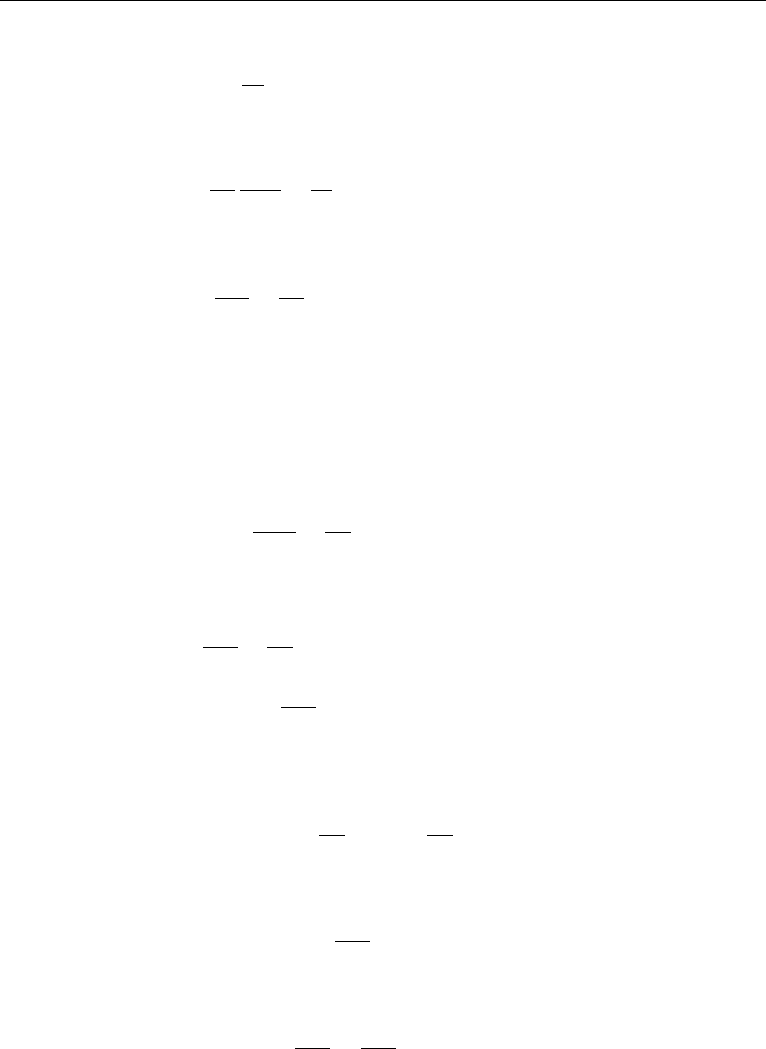
9. Normal Modes in a Continuously Stratified Layer 631
where η is the free surface displacement. These conditions can be combined into
∂p
∂t
= ρ
0
gw at z = 0.
Using equation (14.63) this becomes
g
N
2
∂
2
p
∂z∂t
+
∂p
∂t
= 0atz = 0.
Substitution of the normal mode decomposition (14.52) gives
dψ
n
dz
+
N
2
g
ψ
n
= 0atz = 0. (14.65)
The boundary conditions on ψ
n
are therefore equations (14.64) and (14.65).
Solution of Vertical Modes for Uniform N
For a medium of uniform N , a simple solution can be found for ψ
n
. From equa-
tions (14.56), (14.64), and (14.65), the vertical structure of the normal modes is
given by
d
2
ψ
n
dz
2
+
N
2
c
2
n
ψ
n
= 0, (14.66)
with the boundary conditions
dψ
n
dz
+
N
2
g
ψ
n
= 0atz = 0, (14.67)
dψ
n
dz
= 0atz =−H. (14.68)
The set (14.66)–(14.68) defines an eigenvalue problem, with ψ
n
as the eigenfunction
and c
n
as the eigenvalue. The solution of equation (14.66) is
ψ
n
= A
n
cos
Nz
c
n
+ B
n
sin
Nz
c
n
. (14.69)
Application of the surface boundary condition (14.67) gives
B
n
=−
c
n
N
g
A
n
.
The bottom boundary condition (14.68) then gives
tan
NH
c
n
=
c
n
N
g
, (14.70)
whose roots define the eigenvalues of the problem.
